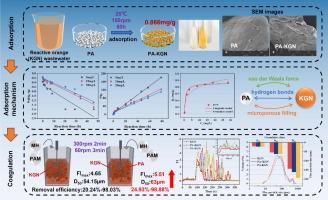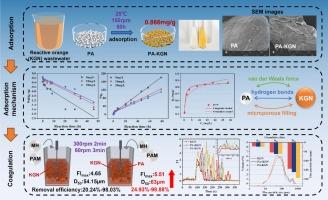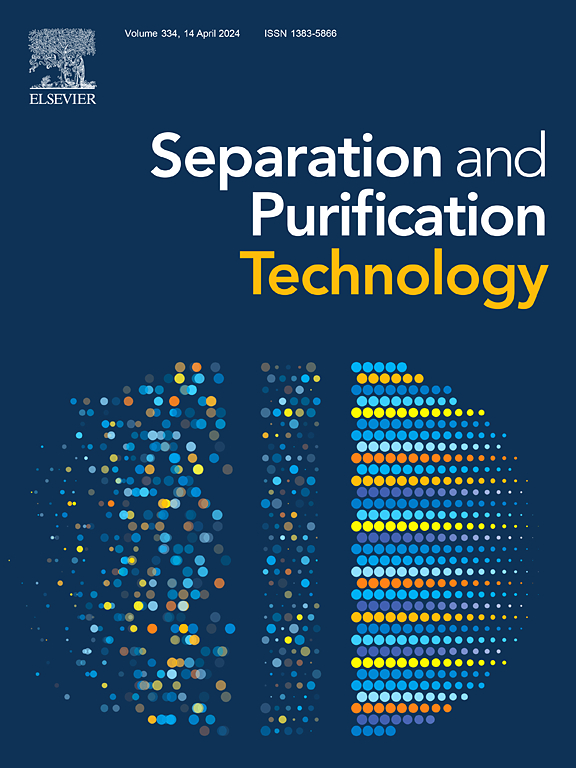微塑料影响纺织废水中染料的去除:吸附能力及其对混凝行为的影响
IF 8.1
1区 工程技术
Q1 ENGINEERING, CHEMICAL
引用次数: 0
摘要
微塑料(MPs)在水生环境中很容易发生吸附反应。纺织废水中的染料可能被微塑料释放和吸附,造成生态污染。本文以聚酰胺微塑料(PA MPs)和活性橙色染料(KGN)为主要研究对象,考察了不同MPs的吸附能力、KGN在PA MPs上的吸附机理以及微塑料吸附对混凝过程的影响。PA MPs 的最大吸附容量为 0.866 mg/g。动力学结果表明,化学吸附可分为三个阶段:膜扩散、颗粒内扩散和动态平衡,是控制吸附过程的主要原因。根据等温线模型,吸附发生在单分子层表面,这表明吸附结果与 Langmuir 等温线较为一致。此外,还研究了微塑料吸附后凝结实验的效果。当活性橙被 PA MPs 吸附后,混凝去除率最大提高了 4.7%,还能提高絮体的生长能力,增强均匀性,使其平均粒径接近 63 μm。最后,介绍了实验过程中吸附和混凝的可能机理,并对今后的工作进行了展望。本文章由计算机程序翻译,如有差异,请以英文原文为准。


Microplastics affect the removal of dye in textile wastewater: Adsorption capacity and its effect on coagulation behavior
Microplastics (MPs) are easily prone to adsorption reactions in an aquatic environment. Dyes in textile wastewater might be released and adsorbed by microplastics, causing ecological pollution. In this paper, polyamide microplastics (PA MPs) and reactive orange dye (KGN) were used as the main research objects, the adsorption capacity of different MPs, the adsorption mechanisms of KGN on PA MPs, and the effect of microplastic adsorption on the coagulation process were investigated. PA MPs had a maximum adsorption capacity of 0.866 mg/g. The kinetic results demonstrated that chemisorption, which can be broken down into three stages: membrane diffusion, intraparticle diffusion, and dynamic equilibrium, was primarily responsible for controlling the adsorption process. Adsorption took place on the surface of the monomolecular layer, according to the isotherm modeling, which indicated that the adsorption results were more consistent with the Langmuir isotherm. In addition, the effect of microplastic adsorption followed by coagulation experiments was investigated. When reactive orange is adsorbed by PA MPs, the maximum increase in coagulation removal efficiency is 4.7 %, it can also improve the growth ability of flocs, enhance the uniformity, and make their average particle size close to 63 μm. Finally, the possible mechanisms of adsorption and coagulation during the experiments are described, and an outlook for future work is given.
求助全文
通过发布文献求助,成功后即可免费获取论文全文。
去求助
来源期刊

Separation and Purification Technology
工程技术-工程:化工
CiteScore
14.00
自引率
12.80%
发文量
2347
审稿时长
43 days
期刊介绍:
Separation and Purification Technology is a premier journal committed to sharing innovative methods for separation and purification in chemical and environmental engineering, encompassing both homogeneous solutions and heterogeneous mixtures. Our scope includes the separation and/or purification of liquids, vapors, and gases, as well as carbon capture and separation techniques. However, it's important to note that methods solely intended for analytical purposes are not within the scope of the journal. Additionally, disciplines such as soil science, polymer science, and metallurgy fall outside the purview of Separation and Purification Technology. Join us in advancing the field of separation and purification methods for sustainable solutions in chemical and environmental engineering.
 求助内容:
求助内容: 应助结果提醒方式:
应助结果提醒方式:


